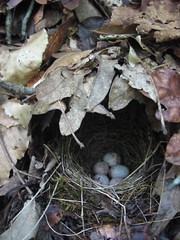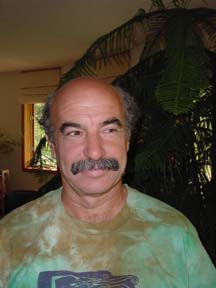On my birthday, April 27, I went down to Ponca to work with Leesia Marshall on her Louisiana Waterthrush research. Up at 4am, hoping to get there before first light to catch the dawn chorus, which is the best time to get some of the recordings she needs. However, a mis-comunication made her think I was coming at 7:30, so she got to sleep in some while I napped in the truck. Got woken up by a tapping on the window. We made a mellow start of it, with some coffee and oatmeal before setting of for a mildly rigorous hike carrying a lot of equipment. It would have been a lot easier if there hadn't been maybe three inches of rain three days previous.
The research site, one of three selected for their varying water and other ecological qualities, was on Leatherwood Creek, accessed from the Ponca parking area on the Buffalo National River. Leatherwood was considered the pristine creek, very little disturbance, little habitation in the area, little history of logging. Big trees, deep woods, great wildflowers, almost all native, but they had been hammered by hail during the storm.
Besides the normal food and water, there were nets and ropes, notebooks and banding tools, tape recorder and boom mic in a padded case, some dry clothes, but not enough. Poles were stashed along the way, and she went back to the truck once for more after walking upstream to another stash that had disapeared. Well, it hadn't walked off, but the marker string in the creek had been washed away by the rain two days before.
We got to the territory that was the focus for the day after about a mile plus of alternate walking and wading. Along the way there were numerous singing Hooded Warblers, the three pairs of Waterthrushes that had claimed territories, but which had already been banded and recorded. Also Ovenbirds, a couple of Kentuckys, an Oriole singingin in the treetops, and several Worm-eating Warblers rattling away. Amazing spot, a great over-curving bluff about 150 yards long, with lots of big rockfalls in the creek, and boulders on the opposite hillside the size of small houses. I speculated that it might have been a cave collapse scene, and she said that theory had been talked about. The upper end was a 30 or 40 foot waterfall that had probably been a sinkhole. We did find one live stalagmite, making a curtain where there was a flow out of a crevice.
We ended with three nets up, my first experience with setting them. One of the target LOWA was caught and banded, the male, and we saw the female carrying nesting material, but two or three hours of searching didn't turn up the nest. The purpose of the banding is to make the birds identifiable as individuals through binoculars. That's accomplished with colored band in addition to the metal band used for the national bird banding database. Leesia had found the three nests downstream, and showed them proudly. She made me find one after shiowing the general area, and it wasn't easy, it being a cup hiden in a small cavity depression in the bank. Most had four or five eggs, full clutches, and were presumably being incubated. That our target birds were still nest building seemed to mean hat they had lost their first nest in the flooding, and in fact one of the points she was researching was nest placement and how vulnerable thay were to rising water levels. She was up there at the peak of the storm flow with a tape measure, gathering data.
Besides the target bird we also caught an Eastern Phoebe (my first solo unsupervised release), a Hooded Warbler, and an Acadian Flycatcher, twice, it flying from the release hand right back into the net. Didn't struggle tho, so it came out easily the second time. We both managed to fall a couple of times, no harm but bruises and dripping clothes all day. I sure was sore the next day, but as much from the nest searching on the steep, uneven and really treacherous hillsides as much as anything. Also caught a dragonfly, which I couldn't ID. Should have taken a picture, which we did with the other critters. I should also mention that there was one Northern Waterthrush, a transient, but using resources in the same area as the Louisianas.
Somewhere around five we started taking down nets, a procedure requiring some attention if the net isn't to be a tangle the next time it's used. Every step of the walking and of the manipulating required attention. When the last net was down, after the Acadian catch, we stashed some poles and headed back for the parking area. Boy it seemed a lot farther going out than going in; I was whooped. Then back at the house, for a simple dinner and showers, mine while Leesia figured out how to digitize some recordings she wanted to use to attract a mystery bird. I got back home around eleven after stopping in Eureka to get email.


